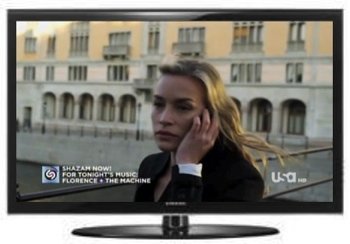Since early 2010, Shazam has been gradually implementing and trialling TV-focused content in its app. The company is aiming squarely at the lucrative second screen app market. These are smartphone or tablet apps that interact with your television, as a kind of “second screen” for content. Shazam Executive VP of Marketing David Jones told ReadWriteWeb that Shazam for TV is “like the mouse for TV.” Meaning you can use Shazam to navigate extra content for TV shows.
How Shazam For TV Works

How does Shazam for TV work? If you see the Shazam logo pop up in a TV program (see screenshot to the left), you can open the Shazam app on your smartphone and access extra content. The first TV show that Shazam “enabled” for this extra content was Covert Affairs, on the USA network. The content available through the Shazam app included episode information and video, character details and a Florence The Machine song that featured in one episode.
Much of the TV functionality in Shazam relies on “calls to action” from within the media itself – in the form of the Shazam logo popping up on your TV screen. That’s a little different to how you use Shazam for music, where you explicitly launch the app to discover song titles. However, in both music and TV, Shazam is leading you to discover extra content. Or, in the company’s parlance, leading you to “tag” content.
With music, it can be as simple as tagging the song title. Often I simply close the app after I’ve discovered who’s singing a song. But if I wanted to, I could browse extra content based on that tag – such as YouTube videos by the same artist, a list of similar artists and other related content.
Show Shazam The Money!
The problem Shazam has faced over the years is that it’s been difficult to generate revenue off the extra content it offers around music. TV offers a potentially much greater revenue platform for Shazam, because they can partner with TV networks and – more significantly – TV advertisers.

Shazam’s evolution into TV programming since 2010
Live TV events are a prime market for the new Shazam. It partnered with a number of brands who advertised on TV coverage of the 2012 Super Bowl and the 2012 Grammy Awards Show. Indeed, more than a third of Super Bowl ads were Shazam enabled.
Shazam has shown impressive growth since its launch in 2008. The company told ReadWriteWeb that its app has over 200 million users now (the image above, which states 180m, is slightly out-of-date) and is adding 1.5 million new users every week. From this increasingly large user base, Shazam is getting 6 million tags a day.

Comparison with Facebook Twitter
According to statistics Shazam compiled, tagging a TV show with Shazam compares favorably with activity on Twitter and Facebook during the day the show airs. In the chart below, Shazam compares its tags with tweets and Facebook likes.

I suspect that the Shazam calls to action had a lot to do with the high engagement. Even so, any positive comparison to Twitter and Facebook is a great sign for a social app.
Shazam’s David Jones told us that tweets and check-ins (from apps like GetGlue and Miso) are not compelling enough for users. The bonus content a user gets on Shazam, he suggested, is more compelling. Twitter and the check-in apps would argue that the social activity they provide around TV programming is more than enough value-add. Shazam is betting that the media content it provides has even more value. Time will tell – right now there seems plenty of room for both approaches to second screen apps.
Second Screen Future
Shifting to the lucrative world of second screen apps is a great move by Shazam. It also has an opportunity to extend its music presence as a second screen experience, as music becomes a more interactive experience too.
The opportunity is there for Shazam, because there isn’t a clear market leader currently with second screen apps. GetGlue, Miso and similar apps are also targeting this market (albeit focusing on social) and doing well, but nobody has become a player with the market recognition that, for example, Spotify has in music.
Let us know if you’ve used Shazam for TV and if so, what you think of it.
